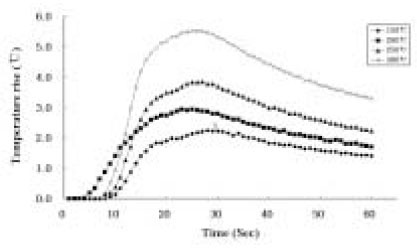J Korean Acad Conserv Dent.
2003 Jul;28(4):341-347. 10.5395/JKACD.2003.28.4.341.
Analysis of temperature rise on the root surface during continuous wave of condensation technique
- Affiliations
-
- 1Department of Conservative Dentistry, College of Dentistry, DSRI, Chonnam National University, Korea. wmoh@chonnam.ac.kr
- 2School of Mechanical Systems Engineering, Chonnam National University, Korea.
- KMID: 1987258
- DOI: http://doi.org/10.5395/JKACD.2003.28.4.341
Abstract
- This study was conducted to evaluate the temperature rise on the root surface while the root canal is being obturated using continuous wave of condensation technique. Maxillary central incisor was prepared for repeated canal obturation. Ten thermocouples (Omega Engineering Inc., Stanford, USA) were placed at 1 mm increment from the anatomical root apex. The real temperature of Buchanan plugger was recorded before insertion into the root canal. The root canal was obturated with continuous wave of condensation technique as described by Buchanan and the root surface temperature was recorded during obturation at 150degrees C, 200degrees C, 250degrees C and 300degrees C temperature settings of System B HeatSource (Model 1005, Analytic technologies, Redmond, WA, USA). After completion of the temperature recording, the dentinal-cementum thickness at each sites was measured. The data were analyzed using one-way ANOVA followed by Scheffe' s test and linear regression test. The results were as follows. 1. When the temperature was set at 150degrees C, 200degrees C, 250degrees C and 300degrees C on the digital display of System B HeatSource, the real temperature of the plugger at the 1mm point from the tip revealed 130.82+/-2.96degrees C, 158.00+/-5.26degrees C, 215.92+/-6.91degrees C and 249.88+/-3.65degrees C respectively. 2. The position of 8 mm from the anatomical apex showed the highest temperature increase at each temperature settings and it was significantly higher than those of other positions (p<0.01). The temperature rise was constantly increased toward coronal portion from apex of the root. 3. The maximum temperature increase on the root surface was 2.37+/-0.09degrees C at 150degrees C setting, 3.11+/-0.12degrees C at 200degrees C setting, 3.93+/-0.09degrees C at 250degrees C setting and 5.69+/-0.15degrees C at 300degrees C setting respectively. These results suggest that it be relatively kind to the supporting tissues of the root that the root canal is obturated using continuous wave of condensation technique at 150degrees C, 200degrees C, 250degrees C and 300degrees C temperature settings on digital temperature display of System B HeatSource.
MeSH Terms
Figure
Cited by 2 articles
-
Comparison of apical sealing efficacies using different plugging depth in continuous wave of obturation technique
Sang-Jin Lee, Jeong-Kil Park, Bock Hur, Hyeon-Cheol Kim
J Korean Acad Conserv Dent. 2007;32(6):491-497. doi: 10.5395/JKACD.2007.32.6.491.Comparison of apical sealing ability of continuous wave of obturation technique using EndoTwinn and System B
Hyun-Ju Shin, Jeong-Kil Park, Bock Hur, Hyeon-Cheol Kim
J Korean Acad Conserv Dent. 2007;32(6):522-529. doi: 10.5395/JKACD.2007.32.6.522.
Reference
-
1. Schilder H. Filling root canals in three dimensions. Dent Clin North Am. 1967. 723–744.
Article2. Nguyen NT. Obturation of the Root Canal System. Pathways of the Pulp. 1994. 6th ed. St. Louis: Mosby Co.;219–271.3. Hand RE, Huget EF, Tsaknis PJ. Effects of a warm gutta-percha technique on the lateral periodontium. Oral Surg Oral Med Oral Pathol. 1976. 42:395–401.
Article4. Marlin J, Schilder H. Physical properties of gutta-percha when subjected to heat and vertical condensation. Oral Surg Oral Med Oral Pathol. 1973. 36:872–879.
Article5. Barkhordar RA, Goodis HE, Watanabe L, Koumdjian J. Evaluation of temperature rise on the outer surface of teeth during root canal obturation techniques. Quintessence Int. 1990. 21:585–588.6. Eriksson A, Albrektsson T, Grane B, McQueen D. Thermal injury to bone: A vital-microscopic description of heat effect. Int J Oral Surg. 1982. 11:115–121.7. Eriksson RA, Albrektsson T. The effect of heat on bone regeneration. J Oral Maxillofac Surg. 1984. 42:705–711.8. Eriksson AR, Albrektsson T. Temperature threshold levels for heat-induced bone tissue injury: A vital-microscopic study in the rabbit. J Prosthet Dent. 1983. 50:101–107.
Article9. Buchanan LS. The continuous wave of obturation technique: 'Centered' condensation of warm gutta percha in 12 seconds. Dent Today. 1996. 15:60–67.10. Weller RN, Jurcak JJ, Donley DL, Kulild JC. A new model system for measuring intracanal temperatures. J Endod. 1991. 17:491–494.
Article11. Choi SA, Kim SH, Hwang YC, Youn C, Oh BJ, Choi BY, Juhng WN, Jeong SW, Hwang IN, Oh WM. Infrared thermographic analysis of temperature rise on the surface of buchanan plugger. J Korean Acad Conserv Dent. 2002. 27:382–388.
Article12. Analytic Technology Corp. Instruction guidelines for system B HeatSource model 1005. 1997. Glendora, California, USA:13. Jurcak JJ, Weller RN, Kulild JC, Donley DL. In vitro intracanal temperatures produced during warm lateral condensation of gutta-percha. J Endod. 1992. 18:1–3.
Article14. Goodman A, Schilder H, Aldrich W. The thermomechanical properties of gutta-percha. Part IV. A thermal profile of the warm gutta-percha packing procedure. Oral Surg Oral Med Oral Pathol. 1981. 51:544–551.
Article15. Lee FS, Van Cura JE, BeGole E. A comparison of root surface temperatures using different obturation heat sources. J Endod. 1998. 24:617–620.
Article16. Floren JW, Weller RN, Pashley DH, Kimbrough WF. Changes in root surface temperatures with in vitro use of the system B HeatSource. J Endod. 1999. 25:593–595.
Article17. Mc Cullagh JJ, Setchell DJ, Gulabivala K, Hussey DL, Biagioni P, Lamey PJ, Bailey G. A comparison of thermocouple and infrared thermographic analysis of temperature rise on the root surface during the continuous wave of condensation technique. Int Endod J. 2000. 33:326–332.
Article18. Biagioni PA, Longmore RB, McGimpsey JG, Lamey P-J. Infrared thermography. Its role in dental research with particular reference to craniomandibular disorders. Dentomaxillofac Radiol. 1996. 25:119–124.
Article
- Full Text Links
- Actions
-
Cited
- CITED
-
- Close
- Share
- Similar articles
-
- Influence of plugger penetration depth on the apical extrusion of root canal sealer in continuous wave of condensation technique
- Comparison of warm gutta-percha condensation techniques in ribbon shaped canal: weight of filled gutta-percha
- Infrared thermographic analysis of temperature rise on the surface of buchanan plugger
- Comparison of sealing ability of different obturation techniques in type II root canals
- Effectiveness of customized master cone on apical sealing in various apical size of prepared root canals






